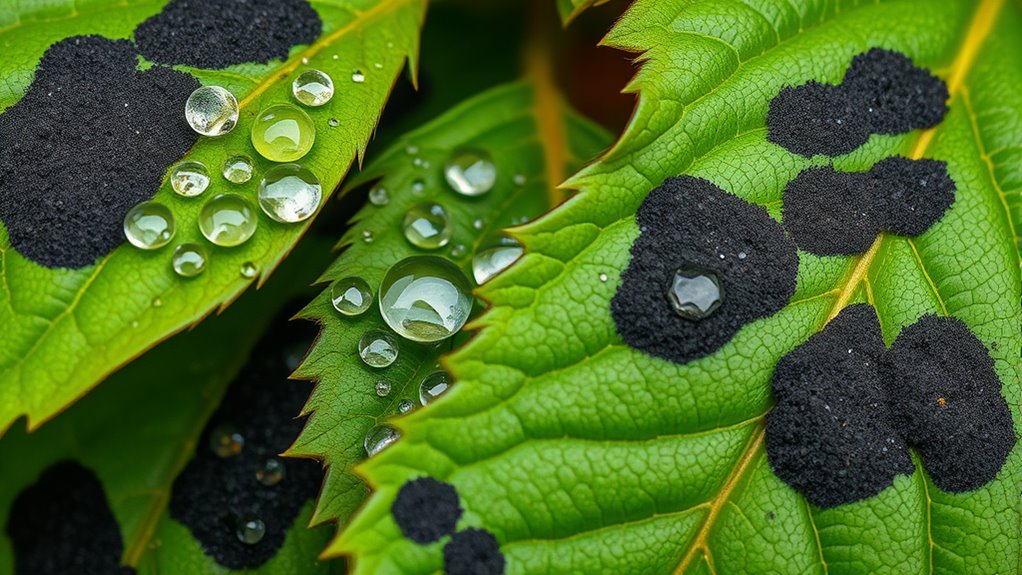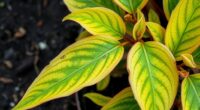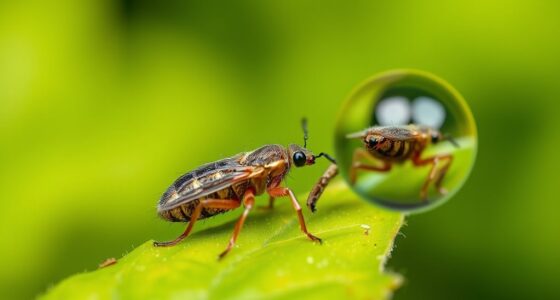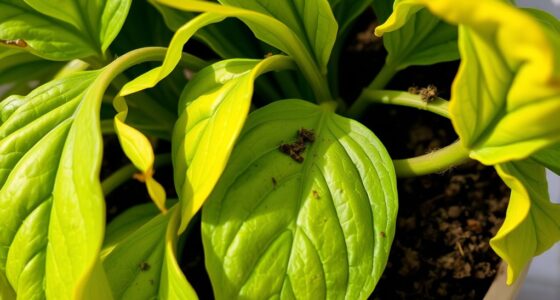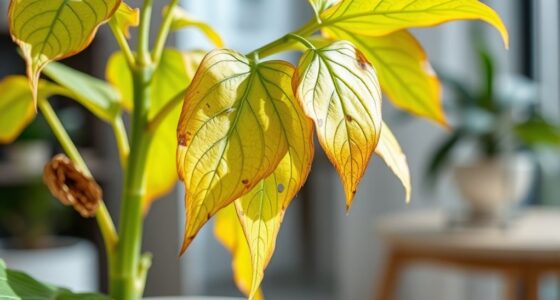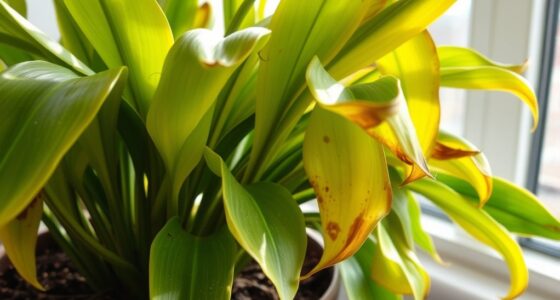If you notice a shiny, sticky coating or black, powdery substance on your plant leaves, it likely indicates honeydew secreted by pests like aphids, scale, or whiteflies. This honeydew can lead to sooty mold, which appears as a dark layer and hampers photosynthesis. Recognizing these signs helps you identify underlying pest issues and plant stress early. To learn effective ways to clean your plants and manage pests, discover more about controlling honeydew and sooty mold.
Key Takeaways
- Honeydew indicates sap-sucking pests like aphids or scale insects are present on the plant.
- Sooty mold develops over honeydew deposits, appearing as a black, powdery or velvety coating.
- The presence of honeydew and sooty mold signals underlying pest infestations affecting plant health.
- Visible pests or sticky residue on leaves help identify the specific insects causing honeydew.
- Addressing pest issues promptly can prevent mold buildup and protect plant vitality.
Recognizing Honeydew on Plant Leaves

How can you tell if a plant’s leaves are coated with honeydew? Look for a shiny, sticky film that often causes leaf discoloration, making the foliage appear dull or darkened. This residue is a clear sign of honeydew, produced by sap-sucking insects like aphids or scale. Sometimes, the honeydew leads to nutrient deficiency in the plant, as it blocks sunlight and hampers photosynthesis. Leaf discoloration from honeydew isn’t just cosmetic; it indicates pest activity that may weaken your plant over time. Check for clusters of tiny insects or sticky deposits on the underside of leaves. Recognizing these signs early helps you identify honeydew presence before it causes more severe issues like mold or further nutrient deficiencies. Insect activity can be a primary cause of honeydew buildup on plant leaves, so monitoring pest populations is essential.
Identifying Sooty Mold and Its Appearance
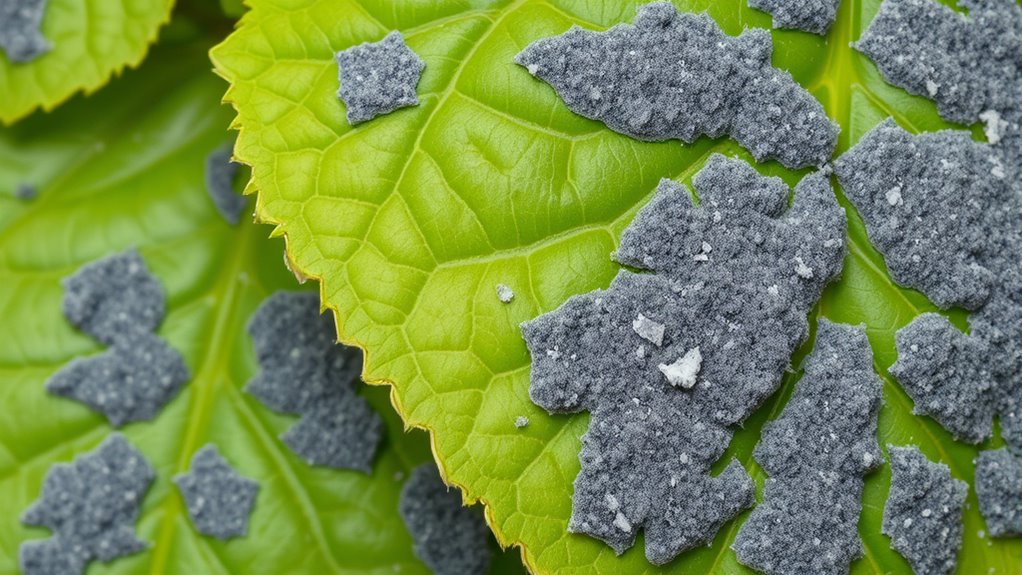
Sooty mold appears as a dark, powdery or velvety coating on the surface of plant leaves and stems, often giving them a black or grayish appearance. You’ll notice leaf discoloration where the mold develops, making leaves look dull or unhealthy. To identify sooty mold, look for these key signs:
Sooty mold appears as a dark, velvety coating causing leaf discoloration and dull, unhealthy plant appearance.
- A black or grayish, velvety layer on leaves and stems
- The surface feels sticky or powdery to touch
- Leaf discoloration caused by mold covering the leaf surface
- An overall dull or unhealthy plant appearance
The mold typically develops over honeydew residue left by pests, but it’s the visual look that confirms sooty mold’s presence. Recognizing these signs helps you determine when mold development is affecting your plant’s health. Effective identification methods include inspecting both the mold and underlying pest activity to address the root cause.
Common Pests That Produce Honeydew

Several pests are responsible for producing honeydew, which can lead to the development of sooty mold on your plants. These pests often cause pest infestation and leaf damage, weakening your plants over time. The most common culprits include aphids, scale insects, whiteflies, mealybugs, and soft-bodied scale. They feed on plant sap, secreting honeydew that coats leaves and stems. This sticky substance attracts mold spores, creating a black, sooty layer. Here’s a quick overview:
| Pest | Damage Type | Identification Tips |
|---|---|---|
| Aphids | Sap-sucking, leaf curling | Small, green/black, clusters on new growth |
| Scale insects | Leaf damage, weaken plant | Hard or soft shells on stems or leaves |
| Whiteflies | Yellowing, leaf drop | Tiny, white flying insects |
| Mealybugs | Sticky residue, leaf curl | White, cottony appearance |
| Soft scale | Leaf yellowing, decline | Soft, waxy covering on stems or leaves |
Additionally, proper identification of these pests can help in choosing the most effective control methods to protect your plants.
The Relationship Between Honeydew and Sooty Mold

Honeydew serves as a sticky, sugary coating that pests like aphids and whiteflies secrete when they feed on your plants. This residue creates an ideal environment for sooty mold to grow, which blackens leaves and hampers photosynthesis. The relationship between honeydew and sooty mold is direct: excess honeydew promotes mold development. To manage this, consider these key points:
- Monitoring pest populations helps control honeydew production.
- Beekeeping practices can minimize honeydew accumulation by reducing pest interactions.
- Regular removal of mold-covered leaves prevents spread.
- Proper honey extraction techniques from honeydew-producing insects can reduce excess residues.
Understanding this connection allows you to better maintain plant health and prevent mold-related damage. Addressing honeydew early limits sooty mold growth effectively.
Health Impacts of Honeydew and Sooty Mold on Plants
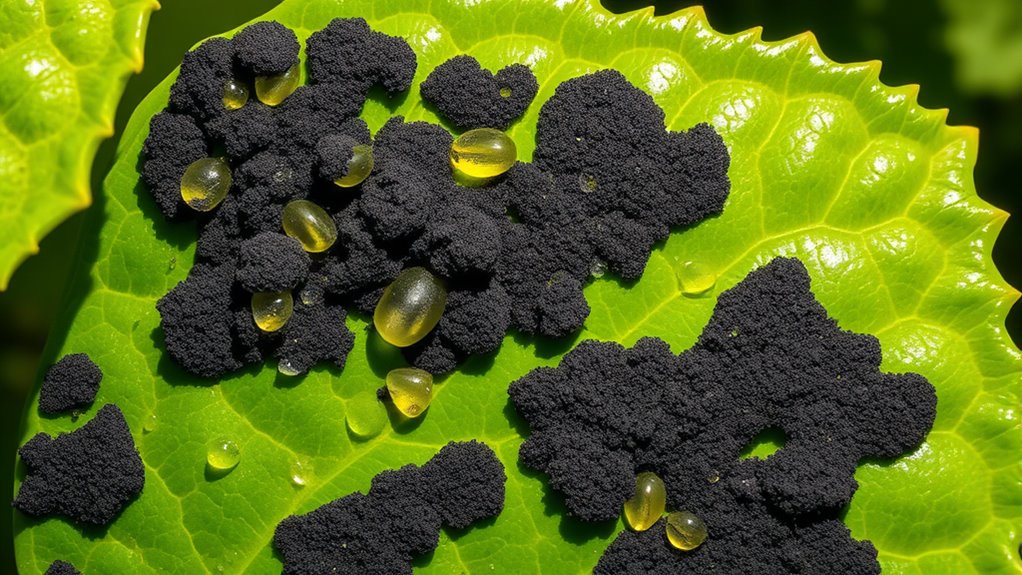
Honeydew and sooty mold can make your plants more prone to diseases, weakening their defenses. The mold blocks sunlight, reducing photosynthesis and stunting growth. You’ll also notice increased plant stress indicators when these issues persist. Using proper maintenance techniques can help prevent the buildup of mold and improve plant health.
Disease Susceptibility Increase
Have you ever noticed how the presence of honeydew and sooty mold can make plants more vulnerable to diseases? Honeydew accumulation creates a sticky surface that fosters fungal growth and invites pathogens. Leaf discoloration caused by sooty mold reduces the plant’s natural defenses. This deterioration can lead to increased disease susceptibility because:
- The mold blocks sunlight, impairing the plant’s immune response.
- Honeydew provides a breeding ground for harmful bacteria and fungi.
- Discolored leaves weaken the plant’s overall health.
- The combined stress makes plants less resistant to pests and infections.
- Understanding plant susceptibility can help in developing effective management strategies.
Photosynthesis Impairment Risks
When honeydew and sooty mold coat plant surfaces, they profoundly hinder the process of photosynthesis. The dark, sticky layer blocks sunlight from reaching the chlorophyll in your leaves, reducing energy production. This results in foliage discoloration, where leaves turn yellow or brown as they struggle to photosynthesize effectively. Over time, the disruption can cause leaf deformation, with leaves curling or wilting due to insufficient nutrients and energy. As photosynthesis declines, your plant’s overall health deteriorates, making it more vulnerable to pests and diseases. The impairment not only affects growth but also weakens the plant’s ability to recover from environmental stresses. Additionally, the presence of data privacy challenges can complicate monitoring plant health through digital tools. Prompt removal of honeydew and mold helps restore proper light absorption, supporting healthier, more resilient foliage.
Plant Stress Indicators
The presence of honeydew and sooty mold signals that your plant is under stress, often indicating underlying health issues. This can result from factors like drought stress or nutrient deficiency, which weaken the plant’s defenses. When stressed, your plant becomes more vulnerable to pests like aphids or scale that produce honeydew. The mold then blocks sunlight, impairing photosynthesis and further weakening the plant. Recognizing stress indicators helps you act early. Here are key signs:
- Wilting or yellowing leaves
- Reduced growth or leaf drop
- Sticky residue on leaves
- Poor overall vigor
Addressing drought stress or nutrient deficiencies promptly can restore your plant’s health and prevent further damage caused by honeydew and sooty mold.
Natural Methods for Removing Sooty Mold

To remove sooty mold naturally, start by gently washing the affected surfaces with a mixture of water and mild dish soap. Use a soft brush or sponge to scrub away the mold without damaging the leaves. After cleaning, improve plant health with proper pruning techniques to remove any hidden sources of honeydew-producing pests. This reduces the likelihood of mold returning. Additionally, applying soil amendments can strengthen roots and promote overall plant vigor, making it less susceptible to pest infestations that cause honeydew buildup. Regularly inspect your plants and maintain good cultural practices. These natural methods work together to keep your plants clean and healthy without the need for chemical treatments. Consistency is key to preventing future sooty mold buildup, especially when incorporating integrated pest management strategies to control pest populations effectively.
Controlling Pest Populations to Prevent Honeydew
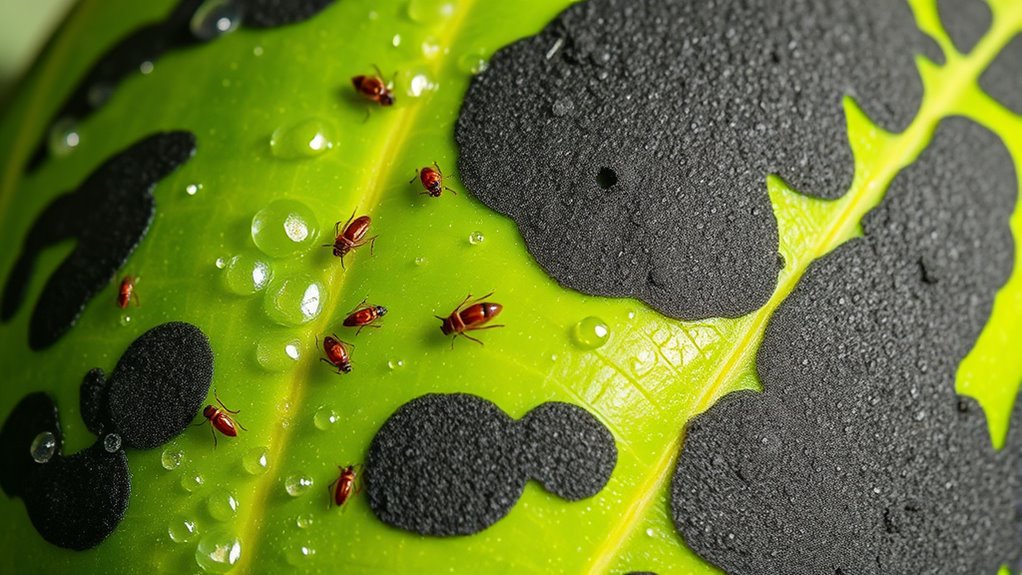
To prevent honeydew buildup, you need to identify pest species quickly and accurately. Keeping natural predators around can help control pest populations without chemicals. When necessary, use targeted pest controls to reduce infestations and minimize honeydew production. Implementing integrated pest management strategies can also support sustainable control efforts by reducing chemical reliance.
Identify Pest Species Quickly
Quickly identifying pest species is essential for controlling their populations and preventing honeydew buildup. Proper pest identification allows you to select the right leaf treatment and target the problem effectively. To do this, observe pests closely, noting their size, color, and movement. Here are four tips:
- Look for distinctive physical features to differentiate pest types.
- Use magnification tools if necessary for detailed pest identification.
- Compare pests to images in guides or online resources.
- Record pest activity patterns to detect infestation levels early.
A thorough understanding of crochet styles for locs can also inform you about protective techniques that minimize pest attraction and plant stress.
Accurate pest identification helps you choose the most effective control methods and prevents unnecessary treatments. Focusing on pest species ensures that your leaf treatment is targeted, reducing honeydew and limiting sooty mold development. Quick, precise identification is key to healthy plants.
Maintain Natural Predators
Maintaining natural predators is an effective way to control pest populations and prevent honeydew buildup. By encouraging beneficial insects like ladybugs, lacewings, and parasitic wasps, you reduce the need for chemical controls. To support these predators, consider improving your soil health with composting techniques and soil amendments, which create a thriving environment for beneficial organisms. Healthy soil promotes robust plant growth, making plants less attractive to pests. Avoid over-fertilizing, as excess nutrients can attract pests. Regularly monitor your plants for early signs of pest activity, and introduce natural predators when necessary. This integrated approach helps keep pest numbers in check, reducing honeydew production and the subsequent development of sooty mold. Staying proactive maintains a balanced ecosystem and healthier plants. Incorporating soil health practices can further enhance the activity of natural predators and overall plant resilience.
Use Targeted Pest Controls
Controlling pest populations directly targets the source of honeydew buildup, helping prevent sooty mold before it starts. Effective pest management reduces the insects that produce honeydew, decreasing the chances of mold growth. To do this, consider these strategies:
- Use targeted insecticides that specifically target pests like aphids or scale, minimizing impact on soil health.
- Introduce natural predators to keep pest numbers in check.
- Adjust watering practices to strengthen plant resilience, making them less attractive to pests.
- Improve soil health with compost and proper drainage, promoting strong root systems that resist infestations.
Chemical Treatments and When to Use Them
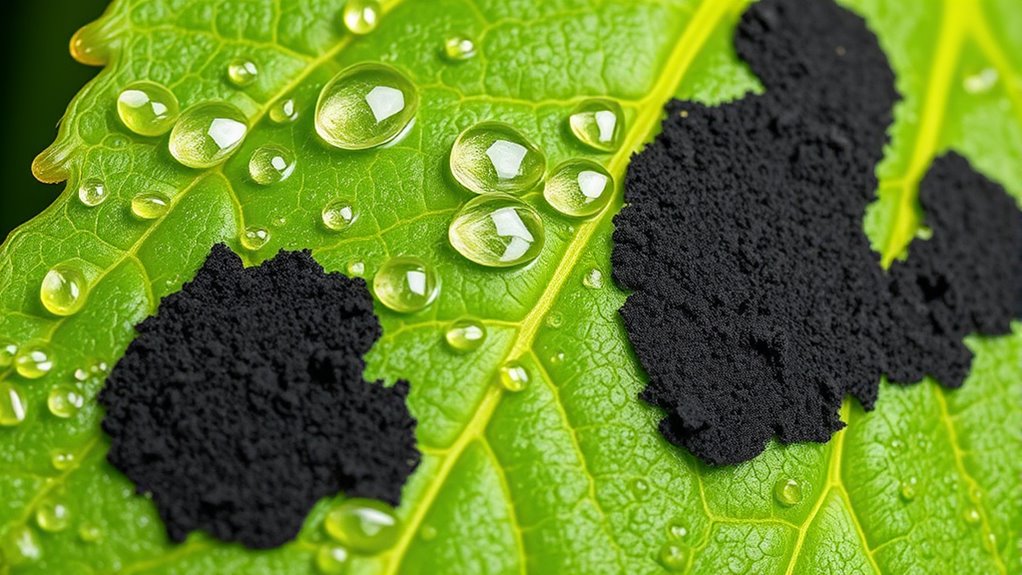
When honeydew and sooty mold become persistent problems, chemical treatments can be effective tools to eliminate them. To maximize effectiveness, consider the chemical resistance of your plants and choose products suitable for your specific situation. It’s vital to apply treatments at the right time—preferably when pests are most active or before mold spreads extensively. Proper application timing ensures the chemicals target pests effectively and reduce the risk of resistance developing. Always follow label instructions carefully to avoid overuse, which can lead to chemical resistance, making future treatments less effective. Use these treatments strategically, focusing on early intervention, and combine them with other management practices for best results. This approach helps keep your plants healthy and free of persistent honeydew and sooty mold issues.
Preventative Strategies to Maintain Leaf Cleanliness
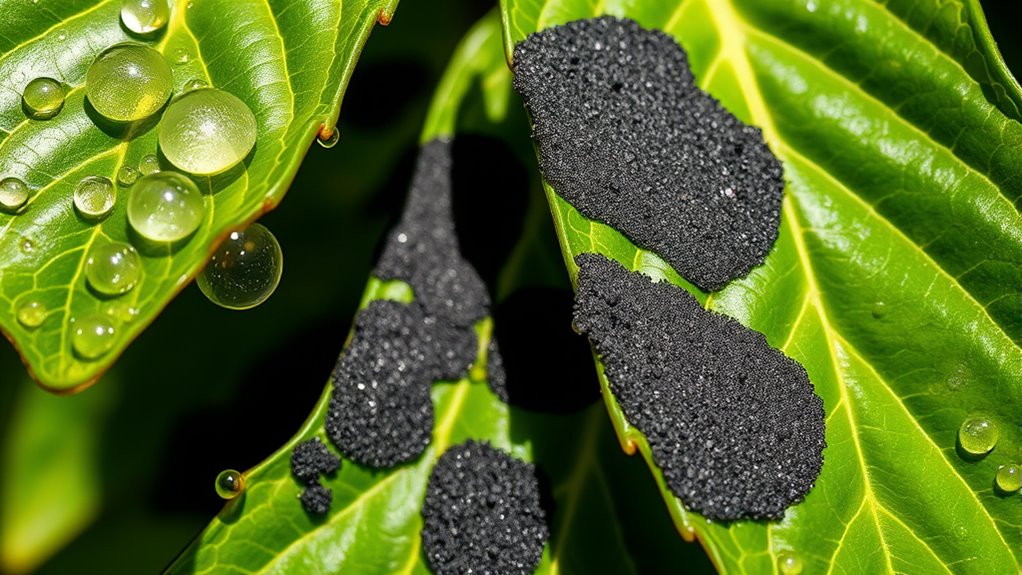
To prevent honeydew and sooty mold from becoming persistent problems, proactive leaf cleanliness is essential. Maintaining healthy leaves reduces the likelihood of mold buildup. You can achieve this by:
- Regularly washing leaves with water to remove honeydew and debris.
- Improving soil nutrition to support plant health and resilience.
- Applying proper pruning techniques to improve air circulation and reduce pest habitats.
- Removing fallen leaves and debris promptly to prevent mold spores from settling.
These strategies help keep leaves clean and discourage pests like aphids that produce honeydew. By focusing on soil nutrition and pruning, you strengthen your plant’s defenses. Consistent care minimizes mold growth and maintains plant vitality, ensuring your garden stays healthy and attractive.
Frequently Asked Questions
Can Honeydew or Sooty Mold Harm Beneficial Insects or Pollinators?
Honeydew and sooty mold can negatively impact pollinator health and beneficial insects. The sticky honeydew attracts pests and can cover flowers, making it harder for pollinators to access nectar and pollen. Sooty mold also darkens leaves and flowers, reducing their visibility and attractiveness. As a result, beneficial insects may struggle to find food, which can decrease their populations and disrupt your garden’s ecosystem.
Are Certain Plant Species More Susceptible to Honeydew and Sooty Mold?
You might wonder if some plant species are more vulnerable to honeydew and sooty mold. Research shows plant susceptibility varies; certain species, especially those with broad, rough leaves, tend to be more vulnerable. These plants provide a perfect surface for mold growth, and their susceptibility increases if they’re near aphids or scale insects that produce honeydew. Understanding species vulnerability helps you manage and protect your garden better.
How Long Does It Take for Sooty Mold to Cause Leaf Damage?
You wonder how long sooty mold takes to cause leaf discoloration and damage. It varies, but mold progression can be quick if the honeydew remains unchecked, often leading to visible leaf discoloration within weeks. The longer the mold stays, the more it hampers photosynthesis, weakening the plant. Regular cleaning and managing pests can slow this process, preventing extensive leaf damage and maintaining plant health.
Is It Safe to Use Organic or Natural Remedies on Edible Plants?
Think of your edible plants as delicate guests at a dinner party. You want to keep them safe and happy, so using organic alternatives and natural remedies is like offering gentle, homemade dishes instead of harsh chemicals. These options are generally safe, eco-friendly, and effective for treating pests and mold. Always follow instructions carefully, and you’ll protect your garden without compromising your plants’ health or your own.
Can Environmental Factors Influence the Development of Honeydew and Sooty Mold?
Environmental factors definitely influence honeydew formation and mold development. If you have high humidity, it creates ideal conditions for the mold to grow on the honeydew. Warm temperatures also speed up mold development, while poor air circulation traps moisture, encouraging mold growth. By managing moisture and improving airflow around your plants, you can reduce honeydew accumulation and prevent the mold from spreading, keeping your plants healthier.
Conclusion
By understanding how honeydew and sooty mold appear, you can catch problems early and protect your plants. Did you know that up to 80% of plant pest issues are linked to honeydew-producing insects? Regular inspection and natural or chemical controls can keep your leaves clean and healthy. Stay proactive, and you’ll enjoy lush, pest-free foliage all season long.
